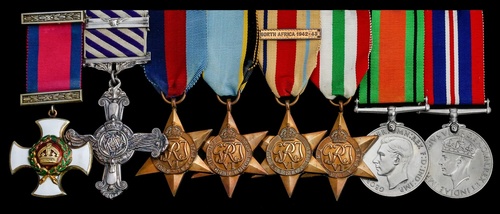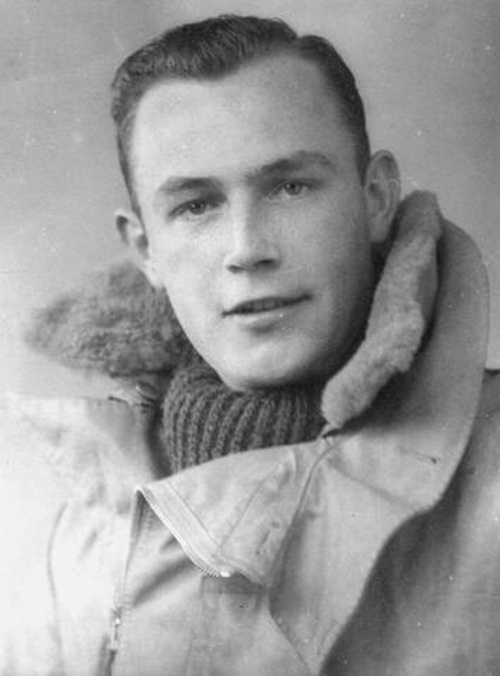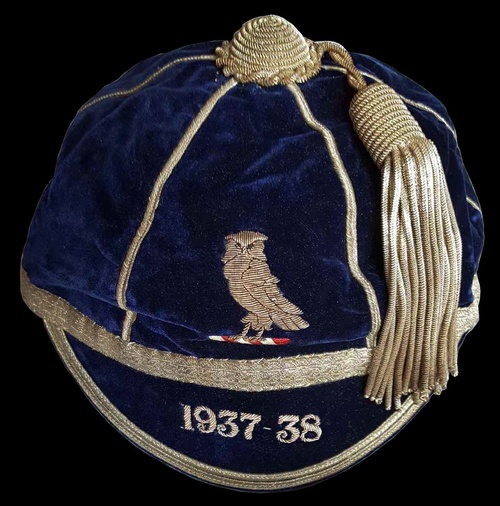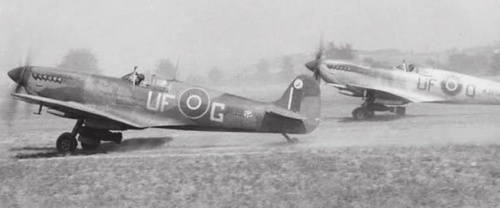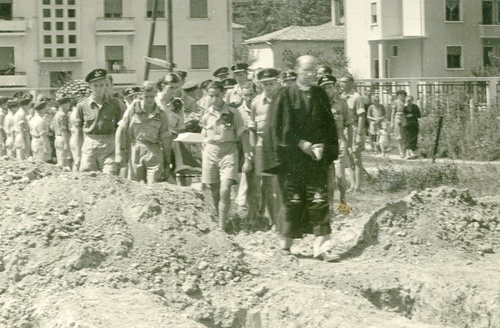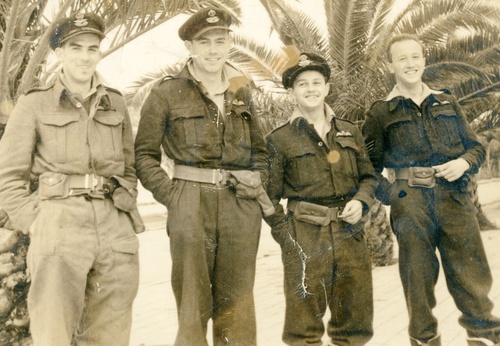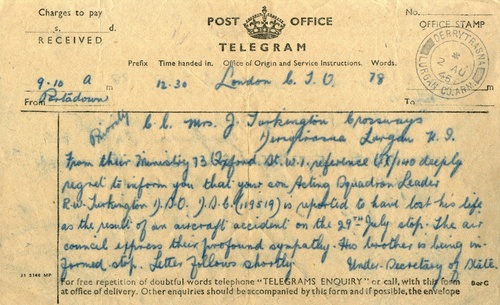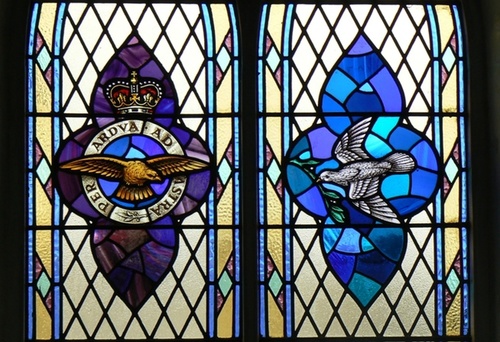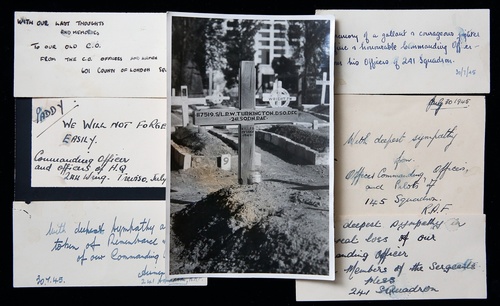Auction: 17003 - Orders, Decorations and Medals
Lot: 717
Sold by Order of a Direct Descendant
'We broke into them and I attacked the starboard aircraft of one formation. Immediately two Me. 109s attacked me from 3 o'clock and above, firing their guns. I turned to meet this attack and started to dog-fight with one of the E./A. I got on his tail and the Me. 109 did aileron turns down to 1,000 feet. When the E./A. pulled out, I was line astern and slightly below. He flew straight and level and I gave him a short burst of cannon and M.G., immediately seeing strikes on the fuselage and black smoke and small pieces coming off. I closed to very short range giving long bursts of cannon and M.G.; white smoke and flames started to come from the engine. The E./A. had slowed down considerably and was going down towards the deck. I was then attacked by two 109s and I broke into them. I returned to base as I was running short of fuel. The Army confirm the E./A. crashed near Venafro.'
'Paddy' Turkington, then a Flight Lieutenant in No. 43 "Fighting Cocks" Squadron, describes one of his victories gained over Italy in November 1943; his combat report, refers.
The outstanding - and deeply poignant - Second World War fighter ace's D.S.O., D.F.C. and Bar group of seven awarded to Squadron Leader R. W. 'Paddy' Turkington, Royal Air Force Volunteer Reserve
With a confirmed total of 11 'kills' to his name - three of them shared - plus a 'probable' and four damaged, he emerged as one of the most successful pilots to hail from the 'Emerald Isle' in the last war, second only to the likes of Wing Commanders B. E. F. 'Paddy' Finucane and J. I. 'Killy' Kilmartin
Having lent valuable service in Operation "Jubilee" off Dieppe in August 1942, Turkington opened his account in a Hurricane of No. 43 Squadron - the "Fighting Cocks"- over North Africa in late November 1942: on converting to Spitfires in the following year, he added swiftly to his score over Sicily and Italy, five enemy aircraft falling to his guns in November 1943 alone
Then in July 1944, as a Flight Commander in No. 241 Squadron, he raised his score to double figures, destroying four Me. 109s, two of them on the same day.
His subsequent - and 'brilliant leadership' - of No. 601 Squadron was marked by numerous episodes of high valour. On one occasion he made no fewer than six attacks on a heavily defended enemy strongpoint until reducing it to 'burning wreckage'; his Spitfire returned to base in a badly shot-up state at an alarming rate - but he treated such episodes 'in a characteristically light-hearted manner'
Tragically he was killed in a flying accident in July 1945, aged 26 years, a tragedy compounded by the circumstances of the Air Ministry's notification of his death: as his mother opened the telegram in question on 2 August 1944, she understood it to be confirmation her gallant son's long-awaited home leave
Distinguished Service Order, G.VI.R., silver-gilt and enamel, the reverse of the suspension bar officially dated '1945'; Distinguished Flying Cross, G.VI.R., with Second Award Bar, the reverses of the Cross and the Bar officially dated '1944', with its Royal Mint case of issue; 1939-45 Star; Africa Star, clasp, North Africa 1942-43; Italy Star; Defence and War Medals 1939-45, together with embroidered R.A.F. 'Wing's' and his R.A.F. Officer's cap badge, the whole stored in a varnished wooden case, with lower recess for the storage of wartime documentation (see below), and as treasured by his mother, generally good very fine (9)
D.S.O. London Gazette 20 April 1945. The original recommendation - submitted by Group Captain H. S. L. 'Cocky' Dundas - states:
'Squadron Leader Turkington took over command of 601 Squadron on 2 August 1944, at which time he was awarded a Bar to his D.F.C. for brilliant fighter and strafing work with 241 squadron. Since that time he has carried out 81 fighter-bomber sorties, bringing his total operational hours to 615 and his total operational sorties to 453. Squadron Leader Turkington is now O.T.E.
Squadron Leader Turkington has been inspiring and brilliant in his leadership while commanding 601 Squadron. As a fighter-bomber pilot he has, by personal example, taught his pilots with determination and accuracy from a low-level; the inevitable return fire he treated in characteristically light-hearted manner, although repeatedly hit himself. In this way he brought squadron morale, spirit and efficiency to the highest possible pitch, and commanded the absolute loyalty and devotion of those serving under him.
Squadron Leader Turkington has a particularly inspiring record as a close support leader. Many times he has destroyed his target through sheer dogged persistence, strafing repeatedly until his ammunition was exhausted. Thus, on 26 December 1944, leading a formation of six aircraft against a strongpoint, four bombs were not seen to explode and the other two went wide; accordingly, he led his aircraft into strafe no less than six times, despite return fire, and only left the target area when the strongpoint was reduced to burning wreckage. On 31 December 1944, under similar circumstances, and with a depleted formation, he strafed eight times to destroy the target completely.
On 5 January 1945, his aircraft was badly damaged by flak; he found it impossible to control, and would have baled out but for the fact that he needed both hands to maintain control. He succeeded in flying it back to base, and force landed successfully despite the fact his aircraft stalled at 160 m.p.h. - a very fine feat of airmanship.
For his great courage, undaunted cheerfulness and successful leadership, I strongly recommend Squadron Leader Turkington for the award of the Distinguished Service Order.'
D.F.C. London Gazette 25 January 1944. Then original recommendation states:
'Flight Lieutenant Turkington took part in Dieppe and came overseas with the Squadron and now has 16 months service with us. He quickly made his mark as a fine leader and during the whole of the North African and Sicilian campaigns showed the greatest skill and enthusiasm to engage the enemy. His score to date is 5 E./A. confirmed and 2 damaged. His consistent resourcefulness, skilful flying and untiring devotion to duty has set a magnificent example to the rest of the Squadron, many months of which were spent under the most arduous conditions. I cannot too strongly recommend this award.'
Bar to D.F.C. London Gazette 29 September 1944. The original recommendation - for an immediate award - states:
'On 29 July 1944, this officer was leading a section of two aircraft which intercepted two Me. 109s. In spite of the fact that only one cannon was firing, Flight Lieutenant Turkington destroyed one of the E./A. and probably destroyed the other, thus brining his score during the last ten days to 3 E./A. destroyed and one probably.
It is chiefly due to the fine example of skill, courage and devotion to duty shown by this officer that the Squadron owes its recent successes, for such was his keenness to engage the enemy that he flew on practically every patrol. On one occasion he was engaged for ten minutes by two Me. 109s, but with great skill and gallantry he warded off all their attacks and eventually they were both forced to retire.'
Robert Wilkinson 'Paddy' Turkington was born in Mhow, India on 13 June 1920, the youngest of three sons of John and Mary Amelie Turkington. His father, a native of Derrytrasna, Co. Armagh, was then employed as a civil engineer with the Indian Railways. Young Robert was educated back home at Lurgan College, where he captained the Rugby XV and had an Ulster Schoolboys' Trial in 1938.
In September 1940, and possibly inspired by events taking place over England, he enlisted in the Royal Air Force. In writing to his mother, he described how he had passed his 'Medical' with flying colours: 'The Recruiting Officer congratulated me on the way I came through - said one in two hundred got excellent all the way through - even eyesight which was perfect.'
Selected for pilot training, he was embarked for Canada and, on gaining his 'Wings', he was
commissioned Pilot Officer in the Royal Air Force Volunteer Reserve.
No. 43 'Fighting Cocks' Squadron - ace status D.F.C.
In July 1942, Turkington was posted to No. 43 Squadron, a Hurricane unit operating out of Tangmere. It was in this capacity that he commenced his operational career, among other sorties participating in Operation "Jubilee", the Combined Operations raid on Dieppe. As noted in Adrian Stewart's Hurricane, he made a 'most creditable landing' on returning from one such sortie in August 1942, enemy flak having shredded his aircraft's elevators.
In November, the Squadron was ordered to North Africa where, in a combat over Algiers on the 10th, Turkington claimed his first victory, a Ju. 88. His next notable achievement occurred on the 27 March 1942, following 43's conversion to Spitfires: He fought a brace of combats in defence of one of our convoys and took a half-share in an Italian S-79 and damaged a He. 111. Having then claimed an Italian Re. 2001 as damaged on 13 May, he likewise shot up a 109 over Sicily on 18 July.
However, it was over Italy in November 1943 that Turkington raised himself to fully-fledged ace status, claiming five victims in combats fought over Volmonte, Volturno and off Capua. These comprised two 109s and a Ju. 88 confirmed - see above cited combat report dated 6 November - in addition to half shares in one of each type. The 109 he destroyed on the 6th was at deck-level and 'very close range'. An indication as to just how close Turkington was prepared to get to his foe may be found in the following combat report, dated 2 November 1943:
'I first attacked from line-astern, giving a 3-second burst of cannon and M.G., opening fire at 150 yards range, closing to 20 yards. Immediately the long-range tank blew up and flames and white smoke came from underneath the fuselage. I broke away and my No. 2 continued the attack. I followed my No. 2 into another attack, giving a long burst of mixed fire from very short range. The E./A. went into a steep turn and I broke away and my No. 2 attacked again. The Me. 109 did a flick-roll and crashed. The combat took place near Val Montone. No return fire.'
Having then damaged a Fw. 190 south-east of Cassino on 15 December, Turkington was 'rested' in January 1944. The award of a richly deserved D.F.C. was announced in the London Gazette in the same month: he had amassed nearly 700 hours of operational flying time, latterly as a Flight Commander.
No. 241 Squadron - double figures - Bar to D.F.C.
As it transpired, Turkington's period of rest ended in May 1944. He was posted as a Flight Commander to No. 241 Squadron and quickly returned to form, claiming four confirmed 109s - and another 'probable' - in a 10-day period in July.
His first victim fell to his guns over Ancona on the 19th, as did his next two, both shot down on the 21st. A week later, over Falconara, he shot down another, in addition to claiming a 'probable'.
He was awarded an immediate Bar to his D.F.C., his total score now standing at eight and three shared destroyed; one 'probable' and four damaged.
No. 601 Squadron - brilliant leadership - D.S.O.
On the day of his last victory with No. 241 Squadron - 29 July 1943 - he received orders to take command of No. 601 (County of London) Squadron. His period of command, which lasted until January 1945, was marked by notable determination and courage of a high order.
Operating in the unit's 'Spitbombers', in close support of the advancing armies, Turkington and his fellow pilots wiped out countless locos and much motor transport. With the arrival of Spitfire IXbs at Fano in September, the Squadron packed an even more powerful punch, so much so that by the end of November it reported it had dropped almost 2,000 tons of bombs.
Much of 601's success was also attributable to determined low-level strafing work, often in the face of heavy opposition. A case in point, as cited in the recommendation for his D.S.O., was Turkington's attack on an enemy strongpoint in December. He made no fewer than six attacks until the target was reduced to burning wreckage. On 1 January 1944, Turkington's Spitfire was severely damaged by anti-aircraft fire in an attack on enemy occupied buildings at Cassiniola. He carried out a wheels-up landing back at base, where his aircraft was found to be 'riddled with holes'.
Awarded the D.S.O., for his 'sheer dogged persistence' and 'brilliant leadership', he was once more 'rested' in January 1945.
'The aircraft began to lose height and suddenly struck the ground'
Turkington, who next took command of his old squadron - No. 241 - expected to be demobbed shortly after V.E. Day in May 1945, but he was retained in Italy on standby. He wrote to his mother to say that that he would be home in August and she re-decorated his room by way of welcome. When a telegram arrived on 2 August she expected it to herald his homecoming: instead it notified her of his death in a flying accident on the 29 July.
A witness to the tragedy later reported:
'Squadron Leader Turkington took off in Spitfire MK 423 on a cross-country flight to Naples. His engine was heard to cut out and he immediately turned to starboard in an attempt to return to the landing strip. The aircraft began to lose height and suddenly struck the ground with the nose and starboard wing. It then burst into flames.'
All ranks turned out at his temporary burial the following day at Mesne British Military Cemetery, where his grave was marked by an oak cross made by the Squadron's carpenter. His remains were later re-interred in the Commonwealth War Cemetery at Padua.
The gallant Turkington - just 26 years of age at the time of his death - is also commemorated on the Portadown's war memorial, in addition to an impressive memorial window at Bannfoot Methodist Church, Co. Armagh. As neatly summarised in one newspaper obituary:
'Squadron Leader Turkington is dead, but his memory will live on. He, and countless others of his ilk and generation have by their deeds of valour laid the foundations of the new world created by their sacrifice.'
Sold with a quantity of original documentation and photographs, contained in the recess of an accompanying varnished wooden case - below a velvet tray bearing the recipient's Honours & Awards - the whole as treasured by his mother to her dying day, and including:
(i)
Irish Rugby Football Union (Ulster Branch), letter inviting the recipient to play a Schoolboys' Trial, dated 17 March 1938; together with his Lurgan College 'colours' for the Rugby XV, namely a velvet cap with silver piping and tassel, by the hatter A. P. Dalzell, Belfast, the peak with dates '1937-38', in excellent condition.
(ii)
Letter from his to his mother on joining the R.A.F., dated 17 September 1940; as quoted above ('… Had a yarn with the Commanding Officer, a very nice chap').
(iii)
A Postagram from No. 43 Squadron, congratulating the recipient on his award of the D.F.C., dated 2 January 1944; and further congratulatory messages from the C.O. of No. 287 Wing, No. 241 Squadron (wishing him 'Good hunting'), No. 601 Squadron and the Town Clerk of Lurgan, the whole in respect of the award of the Bar to his D.F.C., all dated in July-August 1944.
(iv)
The Post Office telegram received by the recipient's mother on 2 August 1944, announcing his death in a flying accident (The Air Council express their profound sympathy. His brother [another R.A.F. pilot] is being informed. Letter follows shorty').
(v)
A letter of condolence from Air Vice-Marshal R.M. Foster, dated 4 August 1947 (' … As you must know by the decorations he has been awarded, your son had a magnificent record in the R.A.F. He was one of the most outstanding leaders in the Desert Air Force. Besides being a most courageous fighter pilot Paddy also had the knack of getting on extremely well with his unit, and whatever Squadron he was in, both as a junior and latterly as a Commander, it was always a very happy concern as well as a very effective one').
(vi)
A letter from Stanley G. Raymond of No. 601 Squadron, likely the unit's chaplain, dated 31 August 1944, in which he forwards photographs of the recipient's temporary grave ('The cross is in oak and was made by the squadron's carpenter'); one such photograph included.
(vii)
Air Ministry letters, addressed to his mother at 'Crossways, Derry, Trasna, Lurgan, N.I.', dated 19 July 1946, forwarding the warrant for the recipient's D.S.O.
(viii)
Buckingham Palace message of sympathy addressed to 'Mrs. J. Turkington' and related illuminated Memorial Scroll, this last in the name of 'Squadron Leader R. W. Turkington, D.S.O., D.F.C., R.A.F.', faded; and Air Council campaign medal forwarding / condolence slip, likewise inscribed.
(ix)
A good selection of original photographs, including the recipient pre-war, among them an image of him with his brothers, Kenneth and Walter, and playing 'beach cricket'; wartime subject matter, including an E.F.T.S. group photograph, the reverse bearing the signatures of the young pilots depicted and, poignantly, a series of images taken at the time of his funeral and burial in Italy.
(x)
A selection of equally poignant cards removed from bouquets of flowers on the same occasion, and returned to his mother in Ireland; largely from his comrades in 241 and 601 Squadrons and including; 'Paddy - We will not forget' (from the C.O. of 244 Wing at Treviso).
Subject to 20% VAT on Buyer’s Premium. For more information please view Terms and Conditions for Buyers.
Sold for
£22,000

